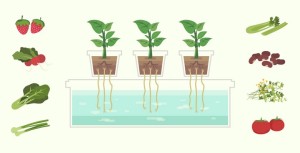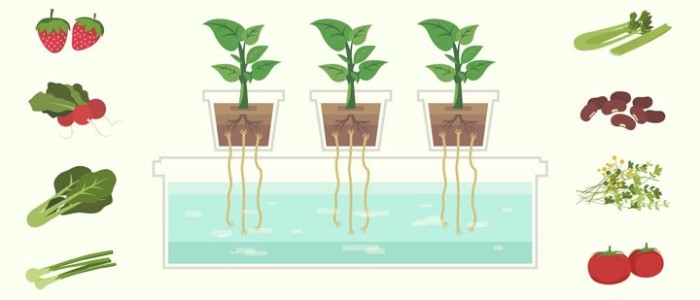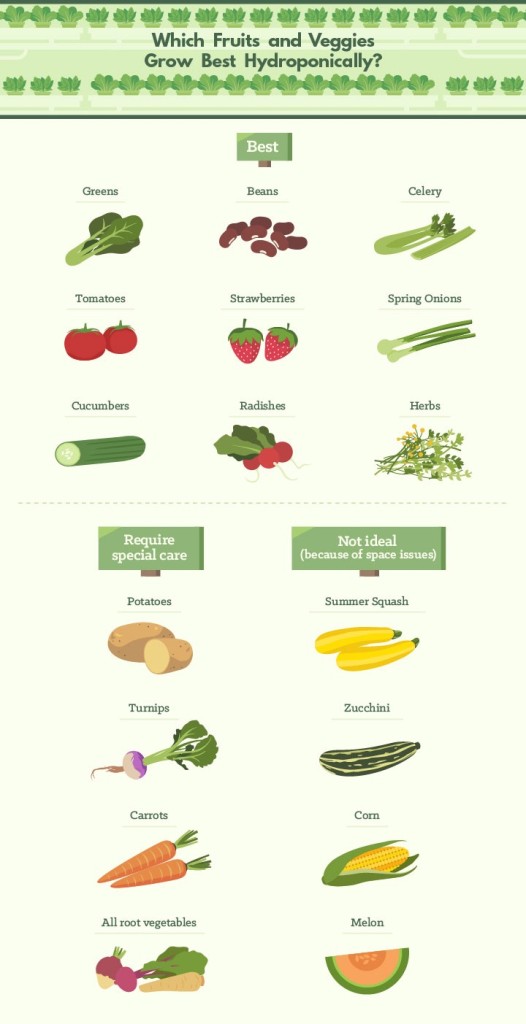Growing Soilless : An Introduction to Hydroponics
The movement to growing your own food is going in creative directions as people seek methods for growing food that fit their own environments. That means condo living, urban centers, and suburban yards. As a result, we’ve seen interest in vertical gardening, community gardens, container gardening and raised bed gardening. Additionally is hydroponics – growing without soil. Here’s a great article describing more about what hydroponics is and should it appeal to you, how to do it.
This article is written by Abby Quillen (March 2015)
 When most people think of gardening, soil comes to mind. But plants don’t actually require it to survive. They mostly need the nutrients and minerals in the soil. Plants can grow in water, gravel, perlite, rice hulls, pine bark, cedar shavings, and other mediums, or even suspended in air.
When most people think of gardening, soil comes to mind. But plants don’t actually require it to survive. They mostly need the nutrients and minerals in the soil. Plants can grow in water, gravel, perlite, rice hulls, pine bark, cedar shavings, and other mediums, or even suspended in air.
The science of soilless gardening is called hydroponics. It may sound like something devised in a modern laboratory, but it’s been around for thousands of years. The essential ingredient is an oxygenated mineral-nutrient solution that’s circulated through plants’ roots.
Some scholars theorize the ancient Hanging Gardens of Babylon, one of the Seven Wonders of the World, was a hydroponic system. The Aztecs grew maize, squash, beans, amaranth, tomatoes, chili peppers, and flowers in high-output chinampas, or floating gardens, which were hydroponic systems. A traditional hydroponics system is still in use on Myanmar’s Inle Lake, and similar systems probably existed in ancient India, Greece, China, and Egypt.
In the early 1600s, the British scientist Sir Francis Bacon, father of the scientific method, conducted formal research on hydroponics, which he called “water culture.” Laboratory experiments continued into the 20th century. In 1937, William F. Gericke applied the experiments to large-scale commercial applications, and the modern hydroponics movement was born.
Today many people identify hydroponics with marijuana growers, who’ve made use of the technology. But much of the world’s greenhouse produce is now grown in hydroponics systems, including some of the lettuce, tomatoes, herbs, and veggies in many supermarkets’ refrigerated cases.
Why Hydroponics?
Growing food without dirt, earthworms, and, sometimes, sunshine may go against common ideas of where healthy food comes from. But hydroponics has taken off for good reason. It offers a number of benefits over traditional soil methods and it may even help solve some of the world’s growing problems.
Water Conservation
Agriculture currently uses 80 percent of the fresh water consumed in the U.S. and 60 percent of it worldwide. Meanwhile a water scarcity crisis currently plagues every continent, particularly arid regions such as the American West.
With a name like hydroponics, it seems soilless systems would use a lot of water. However, on average, hydroponic systems use 10 times less water than soil agriculture because they recirculate fluids and cut waste. In the hope that soilless agriculture will help prevent worldwide water wars in the next century, the National Nuclear Security Agency built a hydroponics greenhouse in New Mexico’s Sandia Laboratory to test the feasibility of growing forage crops for livestock with hydroponics.
Land Conservation
Water is not the only resource in short supply. Many countries, including Great Britain, may face a significant shortage of farmland in the next two decades. Some studies estimate crop yield must double by 2050 to meet projected demands, and scientists warn that will not happen if current trends continue. In the past we’ve cleared forests and grasslands to plant crops, with grave environmental consequences. What if there’s a better way?
Some futurists, including microbiologist Dickson Despommier, are convinced hydroponics is the answer. In soilless systems, roots don’t need to stretch out as much because they’re supplied with all the nutrients they need. Crop yields are typically higher and more stable, and artificial lighting makes year-round crops possible. It currently takes a land area the size of Virginia to produce food for New York City. Despommier envisions cities feeding themselves with vertical skyscraper greenhouses. “If vertical farming in urban centers becomes the norm,” Despommier says, “then one anticipated long-term benefit would be the gradual repair of many of the world’s damaged ecosystems through the systematic abandonment of farmland.”
Less Pesticide Use and Runoff Pollution
Agriculture is the leading cause of water quality problems in the U.S., and pesticides, including endocrine-disrupting atrazine, currently contaminate our watersheds and drinking water. Many hydroponic farmers use zero herbicides or pesticides, and any system with the potential to curb pesticide use is important. Because plants experience less stress and are fed optimally, they’re healthy enough to resist any pests able to enter the greenhouse. Alternatively, organic methods can control pest infestations. Weeds are not an issue with hydroponics, since they need soil to grow.
Food Safety
We’ve all gotten used to headlines about deadly E.coli outbreaks. Twenty-three percent of foodborne illness deaths and 46 percent of foodborne illnesses are linked to eating produce, according to the Center for Disease and Prevention. Soil polluted by livestock waste is often pinpointed as the cause.
Because hydroponic systems are sterile and don’t have soil to be contaminated, disease outbreaks are less likely, especially in clean, well-run systems. (However, hydroponics does not completely eliminate the risk of foodborne illness. Proper precautions are warranted.)
Lower Food Miles
An eat-local movement has erupted across the country. Local produce is usually more nutritious, since vitamin content is depleted by light, temperature, and time. Moreover, local food doesn’t require the expense and energy expenditure of long-distance trucking. But how can people grow food in dense urban centers or inhospitable climates? Hydroponics may be the answer.
Take Emory University for example. The lettuce the school used to serve in their cafeteria had been trucked 3,000 miles before the students ate it. Students built a hydroponics system and now greens are grown 10 feet from the salad bar.
A number of companies, including New York-based BrightFarms, grow tomatoes, greens, and herbs hydroponically on the roofs of grocery stores. The supermarkets sign a contract to partner with BrightFarms for ten years, and in exchange, they’re able to sell the freshest, just-picked produce and eliminate some of their transportation costs.
Emory’s experiment and the growing number of partnerships between hydroponics companies and supermarkets indicate soilless agriculture may provide more local food choices in the future.
Potential Downsides of Hydroponics
Any time people change conventional ways, especially those as embedded in our identities as food cultivation, controversy is inevitable. Hydroponics is no exception, and it does have some potential drawbacks that should be weighed with the benefits. (However, it’s important to evaluate it in the context of the industrialized agricultural system we currently have, rather than an idealized one.)
Scientists are increasingly aware of the importance of the microbiomes in our soil. “There are millions of organisms in a couple cubic centimeters of soil,” explains biologist Jeanne Romero-Severson, and we’ve been unable to grow 90 percent of them in the laboratory. Because we still don’t fully understand the relationships between plants and soil microbes, it remains questionable whether we can reproduce them in a hydroponics system. For that and related reasons, a coalition of organic farmers oppose the USDA’s decision to allow hydroponically grown produce to be certified organic.
Most hydroponic growers claim their greenhouse-grown veggies are as nutritious as, or more nutritious than, conventional veggies, although data is hard to come by. There’s a widespread perception that hydroponic veggies are tasteless or watery, although the evidence is mostly anecdotal. In one blind taste test, hydroponically grown lettuce was rated as just as tasty as conventional or organic varieties. More nutritional analysis and taste testing on a variety of crops would be informative.
Several other issues may make hydroponics challenging or undesirable for some growers:
It can be expensive. Growers, especially large-scale ones, must make an initial investment to buy pumps, pipes, basins, lights, air filters, and fans.
Systems are made of fabricated materials, which require resources to build and maintain.
Commercial nutrient solutions are often mined and produced in factories and they can be pricey.
Systems, especially those with artificial lighting, can use a lot of electricity.
Large systems require technical knowledge and careful monitoring.
Many of those challenges can be mitigated for small-scale home gardeners. Setting up a soilless system can be inexpensive and easy and it’s an excellent way to understand the principles and potentials of hydroponics.
DIY Hydroponics for the Home Gardener
The first and often most daunting decision for any gardener is what to grow. The best veggies to grow in any garden are the ones a person or family enjoys the most. But some plants tend to work better than others in small hydro-systems.
Which Fruits and Veggies Grow Best
Hydroponics systems are already making food easier to grow in deserts and in land-starved countries like Japan where there are concerns about radiation-contaminated soil. If some futurists are correct, hydroponics could help solve impending food, water, and environmental crises. At the very least, soilless systems offer urban apartment dwellers and people living in inhospitable climates the ability to grow food, and that’s no small feat.
The full article including how to make a hydroponic system can be found at
http://www.custommade.com/blog/introduction-to-hydroponics/
Abby Quillen is the author of the novel The Garden of Dead Dreams and the editor of two anthologies. Her articles and essays have appeared in YES! Magazine and The Christian Science Monitor and on Common Dreams, Nation of Change, Reader Supported News, The Daily Good, Truthout, and Shareable. She lives in Eugene, Oregon, with her family. When she’s not writing, she grows vegetables and weeds, bikes and walks as much as she can, and jots down cute things her kids say.




Comments are closed.